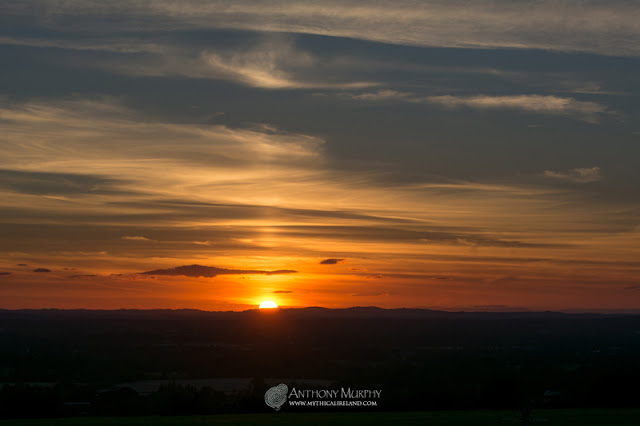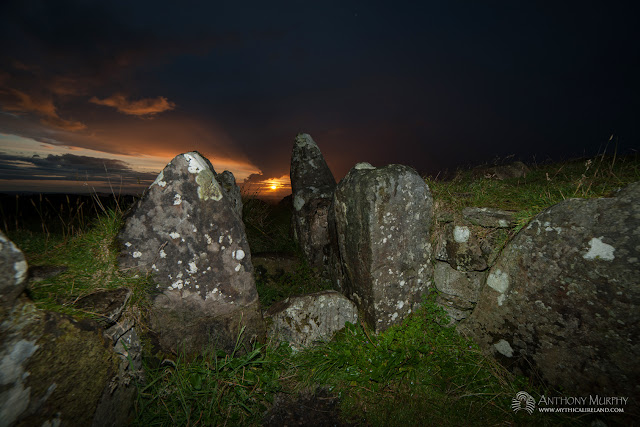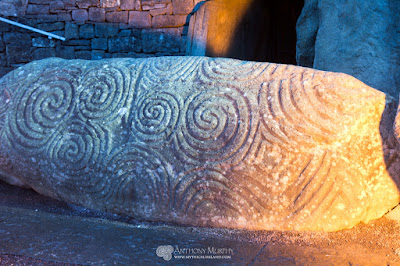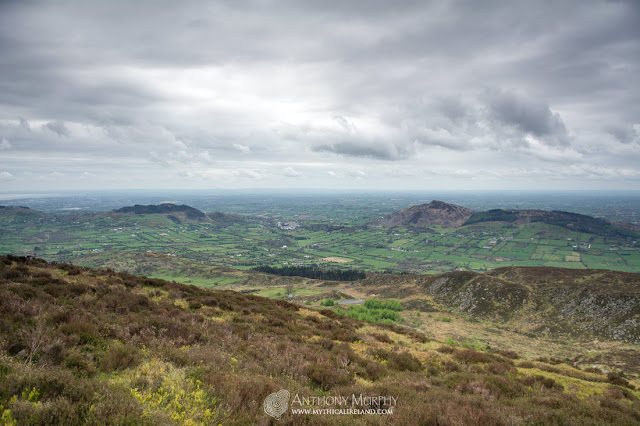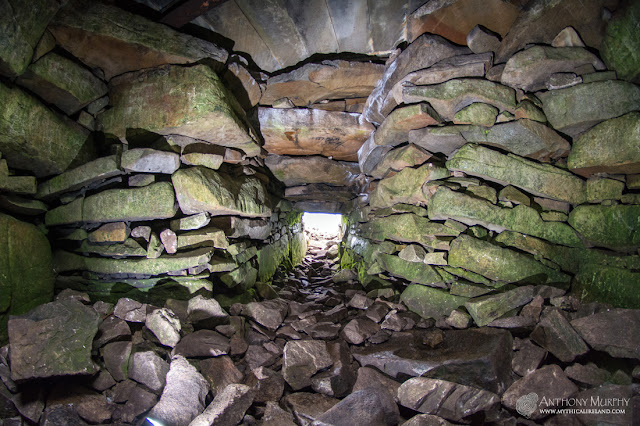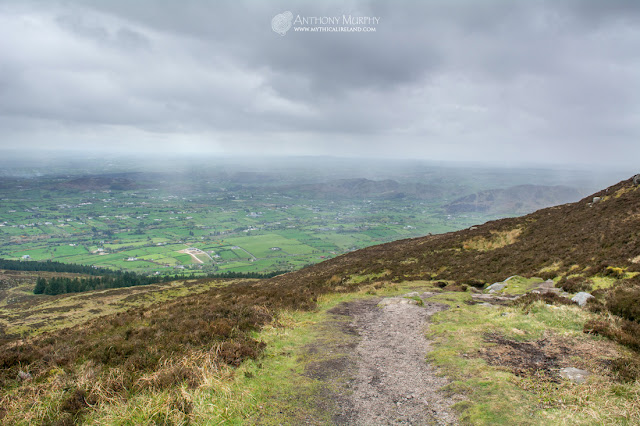THE DREAM OF OENGUS
D Eduard Muller’s translation updated for modern readers by
Anthony Murphy
The story known as ‘Aislinge Oengusso’ (the vision or dream
of Oengus) was first mentioned as a remscéla
(introductory tale) to the Táin bó
Cuailgne in the 12th century Book of Leinster, but is not
recounted there. The story is contained in full in a British Library Egerton
manuscript (1782, folio 70b) dating from AD1517. A translation by Eduard Müller
was published in Revue Celtique in the 1870s. This translation uses somewhat
archaic English, so I decided to update it for a more modern audience. (Note:
It is not always implicit from the dialogue who is speaking, so I have had to use some judgement in a couple of instances. Any errors are, of course, mine).
=======================================================
Oengus was sleeping one night when he saw something like a
maiden near him at the top of his bed. She was the most beautiful woman in
Ireland. Oengus tried to take her by the hands to bring her into his bed, but
she suddenly vanished. His mind was uneasy until the morning.
The episode brought an illness upon him – this vision of a
figure he had seen but with whom he hadn’t spoken. He did not eat any food. The
next night, he saw her again, this time with a cymbal in her hand. She played a
song to him so that he fell asleep. He was there until morning. When he woke,
he did not have any breakfast.
A whole year passed by and she continued to visit him in his
bed so that he fell in love. He didn’t tell anybody about this mysterious
maiden. He fell ill and nobody knew what was wrong with him.
The physicians of Erinn assembled. They did not know what
was wrong. One went to Fergne, the physician of Conn. He came to Oengus. He
knew from looking at Oengus’s face what was wrong with him. He had an illness
of the mind.
Fergne spoke with Oengus and told him that an “accidental
love has fallen on you”.
“My illness has judged me,” said Oengus. “I loved in
heartlessness. And nobody dared say it to the other.”
“It is true,” said Oengus. “I met a beautiful woman, the
most beautiful that is in Erinn, with a distinguished appearance; she had a
cymbal in her hand on which she used to play to me every night.”
Fergne knew that love sickness had seized Oengus, so he went
to fetch the young man’s mother, Boann, to come and speak with him.
“I was trying to cure this man,” said Fergne, “who has been
seized by an uncertain illness.”
Fergne asked Boann to search the whole of Ireland for a
maiden like that which her son had seen at night. And so Boann searched Ireland
for a year, but nothing was found.
Fergne was called for again. “We have not found any help in
this matter,” said Boann.
Fergne said: “Send for the Dagda, so that he may come and
speak with his son.”
 |
| Brug Mac ind Oicc (Newgrange), where Oengus had his dream of the maiden Caer. |
Dagda came. “Why have I been called here?” he asked. “To
help your son,” said Boann. “Your help
is better for him. It would be a pity for him to die. He has an illness. He has
fallen in an accidental love and there is no help for him.”
“What use is it to him to speak with me?” said the Dagda. “My
knowledge is no better than yours.”
Fergne said to the Dagda that he was the “fairy king of
Erinn” and he implored Dagda to send to the fairy king of Munster, Bodb, whose
knowledge was known far and wide.
So they went to Bodb, who asked why they had come. “Oengus
the son of the Dagda is in love this past two years,” said Fergne. “What for?”
said Bodb. “He saw a maiden in his dreams. We don’t know anywhere in Ireland
that this maiden can be found.” Bodb was asked to search Ireland for a woman of
this form and appearance. Bodb agreed and said it would take him a year until
he could answer with certainty.
Fergne went at the end of a year back to the house of Bodb,
at Síd fer Femoin.
“I have investigated all Erinn,” said Bodb, “until I found the
maiden at Loch bel Draccon at the harp of Cliach.”
The two went to Dagda with the good news. “The maiden has
been found,” said Fergne. “Now Bodb insists that Oengus is to come with us in
order to ascertain whether he recognises her as the maiden he saw in his
dreams.”
Oengus was brought in a chariot to Síd fer Feimin. A great
feast was held with king Bodb for three days and nights. Afterwards, Bodb
beckoned Oengus outside, to see if he recognised the woman.
They travelled until they were at the sea, where they saw
150 young women and the maiden was among them. A silvery chain linked every two
of the women, a silvery necklace around the neck and a chain of burnished gold.
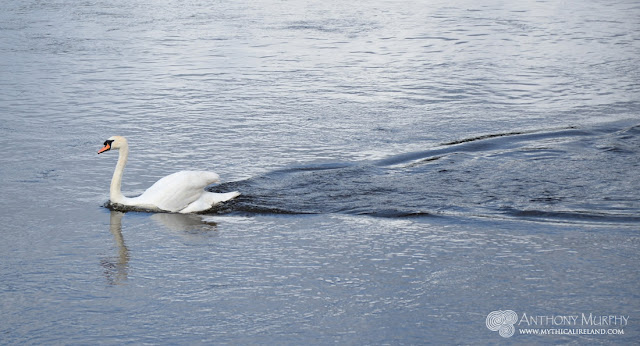 |
| Caer took the form of a swan for a year and a human the next year. |
“Do you recognise the maiden?” Bodb asked.
“Of course I recognise her,” replied Oengus.
“This is not your greatest power,” said Bodb.
“Not so,” replied Oengus. “For I will not be able to take
her with me this time.”
“Who is this maiden, o Bodb?” asked Oengus.
“I know who she is. She is Caer ib Ormaith, daughter of
Ethal Anbual from Sid Uaman in the province of Connacht.”
Oengus returned with Bodb to Brug mac ind Oicc (Newgrange)
to visit the Dagda and Boann. They related how they had seen the maiden, and
had heard the name of her father and grandfather. Bodb suggested to the Dagda
that he should go to Ailell and Medb in their territory in the land of
Connacht, where the maiden was located.
The Dagda travelled with 60 chariots to Connacht. The king
and queen welcomed him. They had a feast and drank beer for a whole week. The
king asked Dagda what was the reason for his journey.
“There is a maiden in your land,” said the Dagda,” and my
son is in love with her and an illness has seized him. I came to ask if you
could give her to my son.”
“Which woman is she?” asked Ailell.
“The daughter of Ethal Anbual.”
“We have no power over her,” said Ailill and Medb, “that we
could give her to him.”
“Let the king be called here,” said the Dagda.
The stuart of Ailell went to Ethal Anbual and told him he
was to go and speak with Ailell and Medb.
“I will not go,” he said. “I will not give my daughter to
the son of the Dagda.”
Ethel Anbual’s answer was related to Ailell. “He will not
come. He knows the reason for which he is called.”
“Not so,” said Ailell. “I will go and my soldiers will be
taken to him.”
Then the household of Ailell and the army of the Dagda rose
up towards the fairies. They destroyed the whole síd. They went to the king who
was in the caves of anxiety.
Ailell said to Ethal Anbual: “Give your daughter to the son
of the Dagda.”
“I cannot,” he said. “There is a greater power in them.”
“What greater power?” asked Ailell.
“Not difficult to say,” replied Ethal Anbual. “To be in the
shape of a bird every day of a year; and the other year to be in human shape.”
“Which year will she be in the shape of a bird?” said
Ailell.
“I don’t know,” said Caer’s father.
Ailell threatened to cut his head off if he did not explain.
So he did.
“She will be in the shape of a bird the next summer at Loch
bel Draccon and beautiful birds will be seen with her and there will be 150
swans about her.”
Afterwards, Ailell, Ethal and the Dagda became good friends
and Ethal was set free.
The Dagda went to his house and told the news to his son.
“Next summer, you must go to Loch bel Draccon and call her
to you at the lake.”
Mac Og went to Loch bel Draccon when he saw the 150 white
birds at the lake with their silvery chains and golden caps around their heads.
Oengus was in human shape at the edge of the lake. He called the maiden to him.
“Come to speak with me, o Chaer.”
“Who calls me?” said Caer.
“Oengus calls you. Come and yield to me.”
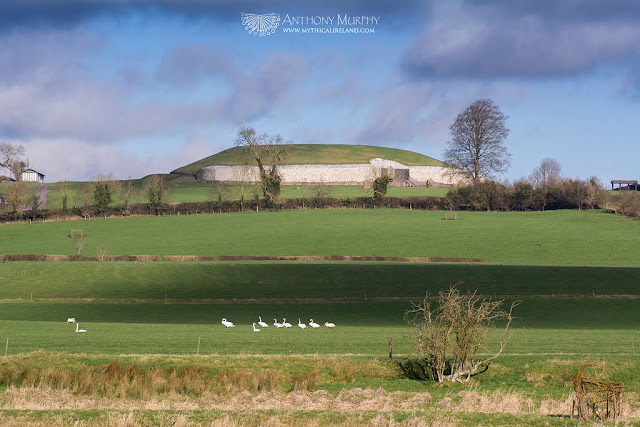 |
| Swans at Newgrange...these birds may have inspired some of the old myths. |
“I will come,” she said. She went over to him. He put his
two hands on her. They slept in the shape of two swans until they surrounded
the lake three times. They left the lake in the form of two white birds until
they were at the Brug of the mic ind Oicc and they made sweet music so that the
people fell asleep for three days and three nights.
The maiden Caer remained with Oengus at the Brug after that.
Afterwards, Oengus became good friends with Ailell and Medb
and as a consequence Oengus went with three hundred others to Ailell and Medb
for the Táin bo Cuailgne.


